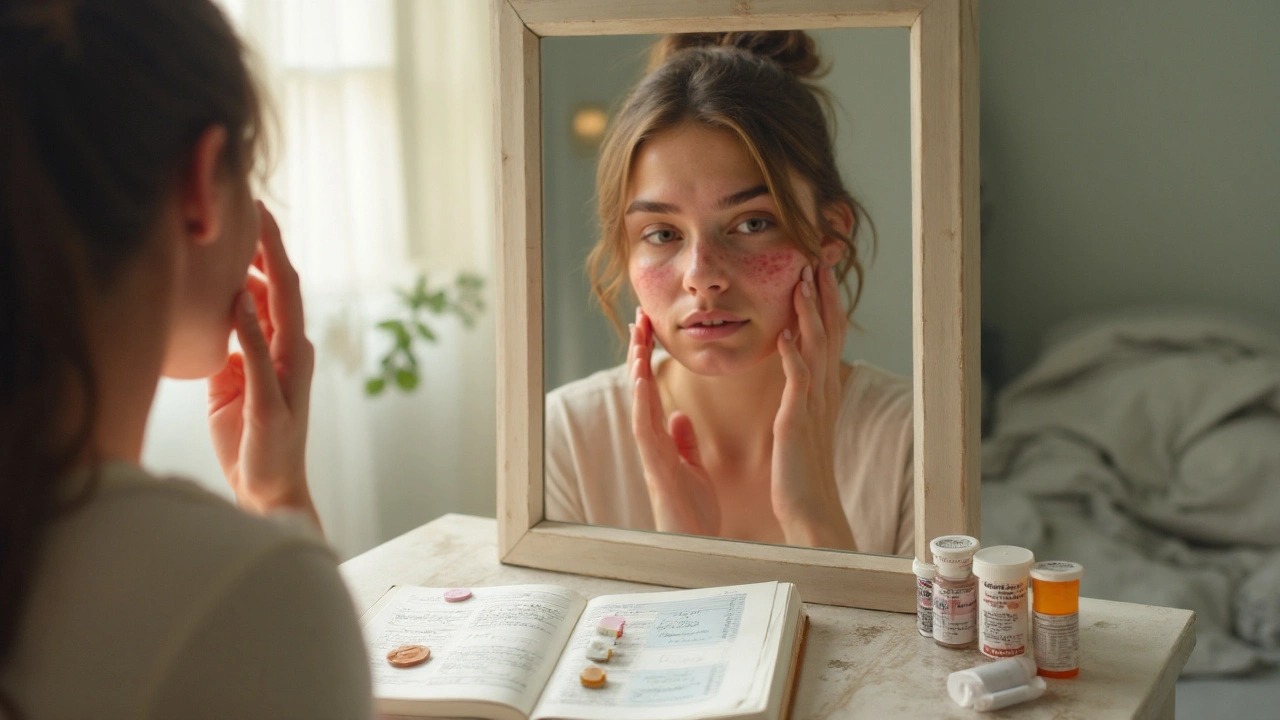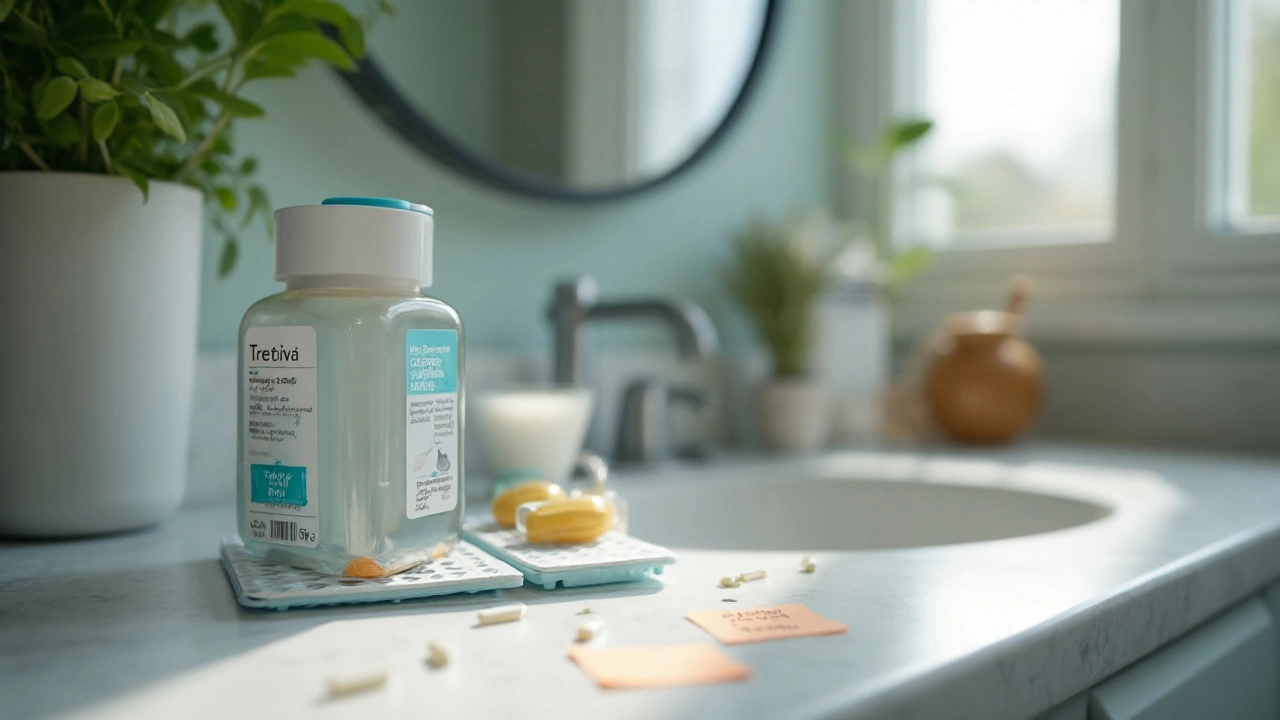Tretiva: Uses, Side Effects, and Real Benefits for Acne Treatment

Ever watched someone’s acne vanish, almost magically, and wondered what secret potion they’d found? There’s no wizard behind the curtain, but there is a pill: Tretiva. It’s the brand name for isotretinoin, a powerful drug that’s been making stubborn acne disappear since the ‘80s. This isn’t some overhyped skincare serum that just dries out your skin for a week. Tretiva, when you dig into it, can feel like the nuclear option for breakouts. But is it as good—and as dangerous—as people say? Pull up a chair, because you’re about to find out if Tretiva is hype, hope, or maybe a bit of both.
What Is Tretiva and Why Is It So Popular?
First up, let’s get clear: Tretiva isn’t some new miracle. It’s actually isotretinoin, which used to go by the famous name Accutane before that brand faded out. Doctors reach for it when almost nothing else is cutting through severe, cystic acne. You know, the type that’s not a couple of pimples before your mate’s wedding, but the serious, painful breakouts that seem glued to your skin. For many, isotretinoin is a last resort after creams, antibiotics, or clever Instagram skincare routines just don’t do the job.
Isotretinoin is a derivative of vitamin A. Sounds innocent enough, but in the skin, it basically turns down the oil factory in your pores, shrinks sebaceous glands, and makes life very tough for acne-causing bacteria. What makes Tretiva stand out is how it tackles acne on several fronts at once. When you’re swallowing these small, red capsules every day (usually under a watchful doctor’s eye), oil production takes a nosedive. The cells that line your pores become less sticky, so there’s less chance for blockages. Even inflammation cools down. This multi-pronged approach is what people love—and sometimes fear—about Tretiva. The effects can be dramatic.
So who takes it? In the UK, many dermatologists don’t hand it out like sweets. You have to go through a gauntlet of blood tests and pregnancy checks (more on that in a minute), since it’s pretty heavy-duty stuff. But when you see before-and-after photos of people who’ve been plagued by acne for years, sometimes even half a year or less on Tretiva changes their whole outlook. Not just on their face, but how they walk into a room, or even smile at themselves in the mirror.
How Tretiva Works: The Science and What To Expect
It’s easy to hear “vitamin A pill for acne” and roll your eyes, imagining another supplement that promises the world. Tretiva, though, plays by different rules. Its main trick is basically throttling back oil production. Your skin’s oil glands—the sebaceous glands—run wild during puberty, stress, or sometimes just thanks to genetics. Tretiva steps in and tells those glands to chill out.
This isn’t all good news, though; dry skin kicks in big time. Suddenly, lips are chapped, and sometimes you feel like you’ve aged overnight with flaky patches. Still, for most people, this trade-off is worth it. The constant oil slick disappears, and with it, the breakouts start to vanish too. There’s more. Tretiva lowers the “stickiness” of the skin cells lining the pores. Less sticky cells mean fewer clogged pores, which means less chance of those deep, painful cysts that make you want to cancel plans.
Expectations with Tretiva need to be realistic. The first month or so can sometimes leave your skin a little worse before it gets better. There’s a thing called the "initial purge." It sounds dramatic (and honestly, it feels dramatic), but it’s temporary. With time—as weeks go by—more people start noticing fewer and fewer breakouts and redness.
The classic Tretiva course runs for 16–24 weeks. Some people need a second go, but many see their acne stay under control for months, sometimes years, after stopping. The medical studies back this up. According to a 2022 review published in the British Journal of Dermatology, over 80% of patients saw long-term improvement, with about 20% needing extra cycles.
If you like numbers, check out the stats on how Tretiva works in the real world:
| Tretiva Treatment Result | Percentage of Users |
|---|---|
| Clear or near-clear skin after one course | 80% |
| Need a second course for full effect | 20% |
| Reported severe side effects | Less than 5% |
| Dry skin/lips as a side effect | 99% |
So if you’re the type who wants results—and is willing to tolerate a bit of discomfort—Tretiva is hard to beat.

The Good, the Bad, and the Scary: Tretiva Side Effects
Every mate who’s taken Tretiva tells you about their lips. It’s a running joke—“Got your lip balm today?”—because dry lips are unavoidable. But side effects go further. Some are common and expected; some can scare you enough to make you want to run in the other direction.
Here are the most common side effects people notice when they start on Tretiva:
- Dry, cracked lips (cheilitis) – Think industrial-grade lip balm and constant reapplication.
- Dry skin on the face and body – Moisturiser should become your new best friend.
- Flaky skin around the nose and mouth.
- Dry or sometimes bloodshot eyes – Eye drops can help a lot.
- Nosebleeds, caused by dry nasal passages.
- Muscle and joint aches, especially if you’re into sports.
Less common, but serious ones deserve attention:
- Changes in mood – Some people report feeling extra sensitive, down, or anxious. If that happens, talk to your doc right away.
- Changes in liver enzymes and cholesterol – This is why monthly blood tests are part of the package.
- Teratogenicity – That’s a fancy way of saying: DO NOT get pregnant while on Tretiva, as it can cause severe birth defects. This is no joke, and doctors run monthly pregnancy tests for anyone who could become pregnant.
- Temporary thinning of the hair – Not bald, but you might notice more hairs in the shower drain.
There’s a lot of debate about long-term effects, especially depression. While the link isn’t rock-solid, anyone who experiences mood changes should check in with the doctor straight away. You don’t mess around with your mental health.
One cool fact: Most side effects ease up and disappear within weeks after stopping Tretiva. The dry lips and skin? Usually gone before you’ve even finished your last box of lip balm. The liver numbers go back to normal too, and the majority of people don’t have any lasting impact.
Tips for a Smooth Ride: Making Tretiva Work for You
Let’s face it, if you go into Tretiva unprepared, the dryness can make you miserable. You really do need a game plan. Here’s the best advice straight from people who’ve been there and done it:
- Invest in a thick, unscented, petroleum-based lip balm. You’ll use more of it than you think possible.
- Pick up a gentle, fragrance-free moisturiser. Don’t go for ‘oil-control’ stuff—your skin wants every bit of hydration it can get.
- Sunscreen isn’t optional. Your skin becomes extra sensitive to sun, so use a broad-spectrum SPF every day, rain or shine.
- Skip waxing or laser hair removal—your skin is more delicate and can easily tear or scar.
- Stay hydrated, not just for your skin but because Tretiva can make you feel a bit drier all over.
- Watch out for joint aches if you’re exercising. Lower your intensity if you need to.
- Let people around you know what you’re going through. Not because you want sympathy, but so if you’re having a rough day, someone gets it.
- If you get blood tests showing high liver enzymes or cholesterol, ask about adjusting your diet—sometimes simple swaps can help.
For women of child-bearing age, use strict birth control. As annoying as the blood tests and forms are, you can’t afford to take chances with this one.
The key with Tretiva is to work with your dermatologist. It’s not a ‘set it and forget it’ kind of treatment. Your doc will adjust your dose, check your bloods, and help you out if side effects start taking over your life. You might feel like a medical experiment with all the tests, but it really is better to catch problems early, not after you feel awful.
Don’t try to go it alone. Online forums are full of advice, but nothing beats real, tailored medical help. If something doesn’t feel right—stickiness in your eyes, sudden mood swings, or pain in your stomach—speak up straight away.

FAQ and Real-World Answers: What People Actually Want to Know About Tretiva
This is where it gets interesting. People Google everything before their doctor’s appointment, but the answers online range from helpful to horrifying. Here’s what comes up most about Tretiva, along with honest, lived-in answers:
- Tretiva and alcohol: You don’t need to live like a monk, but heavy drinking can push up your liver test numbers. Most people stick to a pint or a glass of wine now and then during treatment, but chat with your doc if you’re planning a big night.
- Can you work out while taking Tretiva? Totally, as long as those muscle aches aren’t getting in the way. Listen to your body—if your joints start complaining, go gentler.
- How soon before breakouts stop? Some see changes in the first month, but the real shift tends to come around weeks 8–12. Hang in there through the purge (yes, it’s frustrating), because clear skin is usually just over the horizon.
- Scarring—will Tretiva fix it? It stops new breakouts but won’t erase old scars. Some people choose laser or microneedling after finishing Tretiva to tackle marks left behind.
- Can you take it more than once? There’s no shame in needing a second course. About 20% go back for a round two if acne creeps back after a few years.
- Do you need a prescription in the UK? Always. It’s never legally sold over the counter because of the risk of serious side effects. Beware of dodgy online sellers with sketchy origins—at best, it’s money lost, and at worst, it could be dangerous.
- Does diet matter? Not directly, but a healthy, balanced diet can help your skin recover and may tweak your blood results. Skip the temptation to try extreme diets—it only adds stress.
If you’re on Tretiva, keep a little diary. Doesn’t need to be fancy. Just jot down changes in your skin, mood, and side effects. Sometimes, when things feel tough, looking back at how far you’ve come is the motivation you need to keep going.
Musa Bwanali
August 13, 2025 AT 19:14Solid overview — this hits the practical points people actually need to know.
Tretiva absolutely can be lifechanging for stubborn cystic acne, but like the post says, it isn't a quick fix and it demands respect. Don't treat it like a cosmetic tweak; it's medicine. If you start it, commit to the monitoring and follow the guidance about pregnancy tests, blood work, and sunscreen. You want results, yes, but you also want to come out the other side healthy. Be proactive with moisturisers and lip care from day one.
KaCee Weber
August 16, 2025 AT 02:47This write-up nails a lot of the practical stuff, and I appreciate that it doesn't sugarcoat the dryness.
Been there, done that, and the emotional whiplash during the first months is real. You're not just fighting pimples; sometimes you're fighting your own look and the mirror feels like an adversary. I say that because the mental part deserves as much airtime as the liver tests and lip balm. Bring backup—therapist on speed dial if mood dips, and a friend who texts you when you feel hideous. Also, small but huge tip: start hydrating like it's your job and swap to really rich moisturisers before the purge even begins. It reduces surprise-level discomfort, and no one likes an unplanned flaky apocalypse. Another practical angle: track everything in a tiny notebook. Write down the dates of blood tests, which dose you took, how your mood shifted, and any joint niggles. When you review it later you might see patterns that your doc can actually do something with. About sun sensitivity—don't be cavalier, sunscreen every morning is not negotiable, and hats are underrated allies. I also want to emphasize the pregnancy precautions; they're not bureaucratic red tape, they're lifesaving rules. If you're someone who might conceive, use at least two reliable methods and keep up with monthly tests, no exceptions. And before anybody says "but I don't get depressed", listen—mood changes can be subtle and sneaky. Check-ins with a clinician and honest conversations with friends can catch things early. Lastly, celebrate the small wins; a week of fewer cysts deserves a tiny reward, because those micro milestones keep you sane 😊
Allison Sprague
August 18, 2025 AT 10:21Well written overall, but a couple of phrasing choices are a bit dramatic for no reason.
For example, calling it the "nuclear option" is sensational and not particularly useful. Medicine needs clarity, not hyperbole. Still, the practical tips are solid: SPF, lip balm, moisturiser. The statistics cited seem reasonable but would have benefited from citation links. Also the repeated admonitions about pregnancy are appropriate and necessary.
Sriram K
August 20, 2025 AT 17:54Agree with the above and happy to add a few clinical points.
Isotretinoin reduces sebum and comedogenesis by altering keratinisation and sebaceous gland activity — that mechanistic clarity helps when patients ask why dryness happens. Monthly LFTs and lipid panels are standard because we sometimes see transient enzyme elevations and hypertriglyceridaemia; most changes are reversible after stopping therapy. For those with mood symptoms, baseline screening and early follow-up are prudent. Finally, contraception counselling must be explicit; two forms are typical and monthly pregnancy testing is a must. Work with your dermatologist and primary care provider to coordinate monitoring.
leo calzoni
August 23, 2025 AT 01:27If someone's still prescribing this without strict monitoring they're irresponsible.
jess belcher
August 25, 2025 AT 09:01yep oversight is everything
not all doctors cut corners but the ones who do give the rest a bad name
Deborah Summerfelt
August 27, 2025 AT 16:34Everyone's acting like it's either a miracle or a monster and both extremes are tiring.
Reality is usually in the middle: it helps some people dramatically and others not at all, and a subset get side effects that matter. I'd rather see honest, individualized counselling than broad pronouncements. People should be allowed to decide for themselves once properly informed. The moral panic surrounding the drug's risks sometimes drowns out useful, practical advice. So stop yelling and start educating.
Maud Pauwels
August 30, 2025 AT 00:07Nice counterpoint — factual and calm.
There is nuance here and the decision really should be tailored. If someone is frightened by the risks, reassure them with data and a plan. If they're desperate for results, give them the support and monitoring they need.
Scott Richardson
September 1, 2025 AT 07:41Regulation should be tighter everywhere; access without proper controls is a mess.
People buy pills online and then wonder why they end up with complications. Strong meds need strong systems.
Laurie Princiotto
September 3, 2025 AT 15:14Totally — the sketchy online sellers are a nightmare :)
Also, people need to stop thinking that a pill absolves them of responsibility; follow-ups matter. If you're going to take something that powerful, do it the right way.
Musa Bwanali
September 5, 2025 AT 22:47One more thing about mood and support.
Don't underestimate small safety nets: tell one close friend about the treatment, set weekly check-ins, and if you have a history of depression bring that up before starting. The monthly blood tests catch liver and lipid issues, but mental health needs its own safety plan. Your skin journey is medical and emotional. Treat both with seriousness.
Sriram K
September 8, 2025 AT 06:21Practical follow-up notes for anyone considering this:
Start with a clear treatment goal and a target cumulative dose discussed with your dermatologist. Many practitioners use a weight-based total dose to reduce relapse risk. Stick to monthly labs during treatment and check again a month or two after stopping. For people who can conceive, document contraceptive methods and do monthly pregnancy testing as required by local protocols. If labs show rising triglycerides, dietary changes and dose adjustment often help; rarely do we need to stop therapy. And if mood changes occur, pause and get mental health input rather than soldiering on.
Allison Sprague
September 10, 2025 AT 13:54That long reply was spot on but a phrase jarred me: "emotional whiplash" feels colloquial to the point of cliché.
Still, the content was useful. If you're tracking symptoms, please date entries and keep them concise. Doctors appreciate clear, short notes rather than a flood of feelings with no timeline.